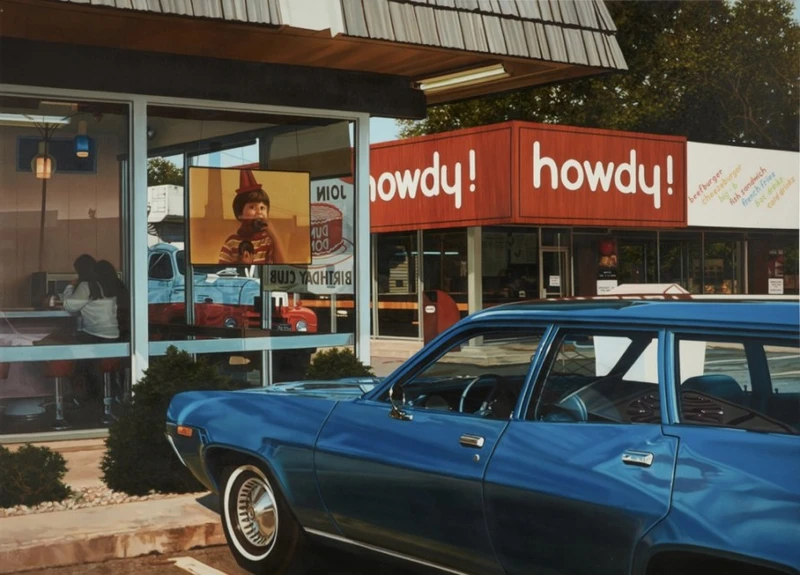DRIVE: North America and the Open Road
28 Feb-5 Apr 2022


From drive-ins and drive-throughs, to road trips on the open highway—the automobile is an essential part of American culture. Certain routes and journeys have become the stuff of legend, while the American open road has become an established point of reference and inspiration for filmmakers, novelists, painters and sculptors. In this display, which brings together work by leading American artists, the automobile is represented both as a sign of empowerment, success and individuality, and as a symbol of displacement in a decaying, depersonalised urban landscape.
Forming the heart of the display are paintings by Richard Estes (b.1932, Kewanee, Illinois); Robert Cottingham (b.1935, Brooklyn, New York); Tom Blackwell (b.1938–d.2020); John Baeder (b.1938, South Bend, Indiana); and John Salt (b.1937 Birmingham, UK–d.2021 Shropshire, UK). These painters, who are often grouped under the label ‘Photorealist’, each developed their own distinct pictorial language, but share a detached, naturalistic style with flattened pictorial space, a close attention to surface and a high level of detail. Their subjects range from glossy cars with chrome bumpers, trucks, motorcycles and gas stations, to the symbols of mass consumerism: diners and fast food restaurants, and the advertising billboards and neon store signs of the highway.
‘The Highway’ is treated as an archetypal image in the work of painter Allan D’Arcangelo (b.1930, Buffalo, New York–d.1998, New York, New York), whose iconic paintings of abstracted road signs, and industrial landscapes draw on the experience of driving through America. Following a brief stint in the army, D’Arcangelo began painting in 1955; the very next year, the Federal Highway Act came into effect and initiated the construction of 41,000 miles of roads that spanned the American nation and transformed its landscape. Although the vast network of roads provided greater mobility and freedom, D’Arcangelo felt compelled to convey its damaging effect on communities and natural areas. His paintings present a remote and depersonalised landscape as seen through a car windshield, the sunlit roadways of "the American highway speeding vigorously into the future—a knife–edged path punctuated by billboards, route and speed-limit signs".
The proliferation of signs, symbols and advertising imagery on the open road would prove influential to artists working in this time: indeed a number of artists in the mid 20th century trained in advertising and commercial roles in the graphic arts before, or alongside, their own personal pursuits. Robert Indiana (b.1928, New Castle, Indiana–d.2018, Vinalhaven, Maine), a self-described ‘American painter of signs’, used text and symbols to create compelling works that blend the literal and the visual, so that divisions between word, object, and idea are conflated into one visual field. His dynamic use of military signage, stenciled letters, and a limited color palette creates visual impact. Indiana’s work is explored in depth in a solo presentation at the Yorkshire Sculpture Park which coincides with this display.
A number of sculptures included in the display treat the automobile as artistic medium, rather than as subject. ‘Glut’ (1986-89; 1991-95), the final sculpture series by the legendary American artist Robert Rauschenberg, was initiated after his visit to Houston, Texas; a state then in the throes of a recession due to a glut in the oil market. Rauschenberg collected gas-station signs and deteriorated automotive and industrial parts littering the landscape, later transforming these scrap-metal detritus into a series of wall reliefs and eccentric freestanding sculptures. Also on display is 'Felonious Orchid' (2003), an arresting sculpture by John Chamberlain, which was skilfully constructed from discarded pieces of brightly painted steel, with visible signs of wear and tear, including rust and scratch marks. The piece echoes Chamberlain’s early work in which discarded auto-body parts were bent, bolted and welded together.